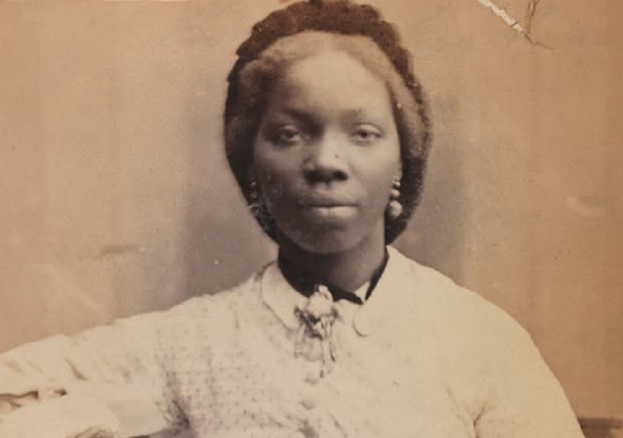The portraits are one highlight among a wide-ranging showcase of some of the earliest photographs in existence of black and Asian actors and musicians, diplomats and dancers, labourers and politicians living in Britain, long before the famous arrival of the Caribbean immigrants on the Empire Windrush in 1948.
Other identified sitters include Peter Jackson, the champion boxer billed as the “Black Prince”; composer Samuel Coleridge-Taylor; Dadabhai Naoroji, who beceame the first British Indian MP when he was elected for Finsbury in 1892; and Ndugu M’Hali, known as Kalulu, given as a slave but freed and treated as an adopted son by the explorer Sir Henry Morton Stanley.
Sarah Forbes Bonetta was a society figure by the time she was photographed in a shimmering gown by Camille Silvy. Born into a Yoruba royal family, she was five when she was captured in a slave hunt in which her parents were killed. She was given the name Forbes after a Royal Navy captain, Frederick Forbes, who convinced her captors to send her as a gift to Queen Victoria instead of keeping her as a slave. The Queen arranged for her to be fostered and paid for her education. She later married a wealthy merchant and returned to live in Lagos with him, and her eldest daughter became Victoria’s god-child.
The exhibition, Black Chronicles, Photographic Portraits 1862-1948, opening on 18 May, will draw on rare photographs from the National Portrait Gallery’s own collection, as well as new acquisitions including portraits by Angus McBean of Les Ballets Negres, the first all-black ballet company, and photographs of Pandit Ram Gopal, a pioneer of classical Indian dance in Britain.
New prints have also been made from glass plate negatives recently rediscovered in the Hulton Archive by the photo and film charity Autograph ABP. Curator Renée Mussai, head of ABP’s archive, said the aim of the exhibition was to share their research with new audiences in order to cast new light on social history as well as the story of photography.
“Not only does the sitters’ visual presence in Britain bear direct witness to the complexities of colonial history, they also offer a fascinating array of personal narratives that defy pre-conceived notions of cultural diversity prior to the second world war,” she said.
Black Chronicles: Photographic Portraits 1862-1948 is at the National Portrait Gallery, London, until 11th December.

